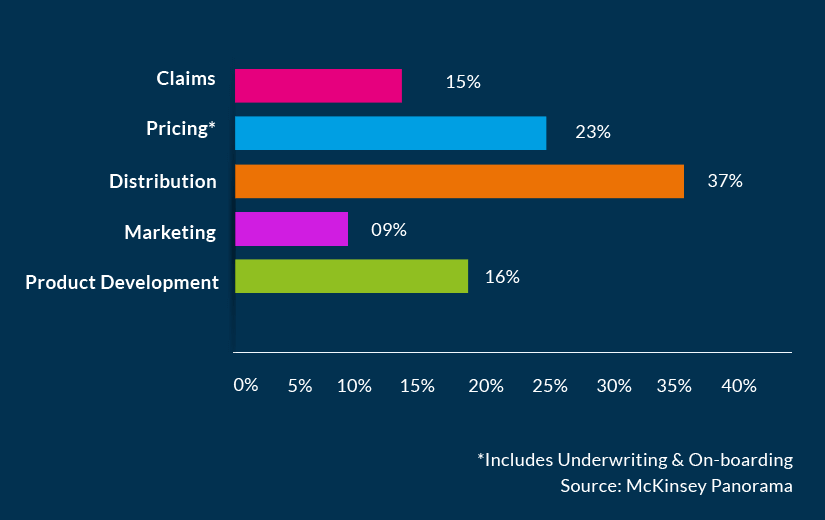Today, insurers have understood that tech innovations aren’t threats, and started grabbing insurtech as a door of opportunity. There is a strong demand for innovative technologies and insurers are deliberately looking for hands in the innovative process.
The groundbreaking advancements continue to transform the industry, thereby allowing you to think outside-the-box and do things that are unique from the norms. The global insurtech market revenue is forecasted to be $10.14 billion by the end of 2025.
You’ll find this article useful if you’re looking to reshape your insurance business into technology-driven. Here, we will walk you through the enormous technologies and various digital marketing techniques that have enabled the insurance industry to set its path toward digital transformation.
What is Insurtech?
Today, it’s inevitable for insurance businesses to act faster and deliver customer-centric, modernized solutions. The integration of insurance and technology is knocking down the walls of innovations for a massive digital transformation.
Insurtech enhances the speed of operations digitally, with the integration & innovation of new technologies.
Disruptive Technologies that are Reshaping the Industry
For sure, scenarios caused by technology innovations aren’t any fiction-based stories. They tend to permeate through every insurance operation, right from policy pricing, claims management, and customer service to underwriting and even risk analysis.
To survive in the competition, being immersed in the traditional myths is not going to work. You’ll have to adapt to the new reality and play. Let’s take a look at some of these disruptive technologies.

Penetration of disruptive technologies across the insurance industry
Also Read
1. Artificial Intelligence
It’s no longer a need to hire customer service employees to respond to every customer’s concern. Insurtech streamlines communications through AI-enabled chatbots that respond to inquiries 24/7. Lemonade, is a US-based digitalized insurtech company that deploys its services almost entirely through virtual assistants.
By leveraging AI and behavioral economics, this company was able to claim thefts, assign premiums, cancel policies, and resolve customer issues. It makes them avoid bureaucracy and paperwork, such that it can process a claim in 3 minutes.
Fukoku Mutual Life Insurance company in Japan switched to AI technology and deployed 34 employees to other services and was able to save about $1.25 million in a year.
Chatbots once built can run according to the set scripts automatically. AI-enabled chatbots can handle multiple data streams and insurance operations that surpass the need for human intervention. It is capable of collecting customer data, processing queries, detecting spam messages, and offering reliable feedback.
Greater Than (Sweden), IBM, and LexisNexis Risk Solutions use AI tools to perform complex risk assessments and write policies based on individual holders’ behavior.
2. Mobile Apps
You can avoid policyholders spending money on documents’ printouts and photocopies. Instead, allow them to simply click a picture of the documents with their phone and submit it through the mobile app.
For example, Trov, a San Francisco digital insurance leader, uses AI tech and launched its app to offer personal auto and mobility insurance which is aligned to vehicle owners’ needs.
Also, Root Insurance has made a record in the United States by providing car insurance by tracking driving behaviors entirely through its smartphone app.
3. IoT Devices
Through IoT-enabled monitoring devices and wearables, auto, P&C, and even health insurers can effectively implement real-time risk monitoring.
For instance, John Hancock, one of the oldest North American life insurers, monitors health & fitness data through fitbits and smartphones. Instead of sending humans to inspect, casualty property insurers can use drones to inspect properties like rooftops, disasters, and accident zones.
With IoT devices fitted into smartphones or vehicles, auto insurers can directly monitor the driver’s behaviors. If you’re an auto insurer, then you can track your insured’s vehicles locations and measure driving speeds, braking patterns, acceleration, and others.
Hippo is a licensed UK-based property casualty insurance agency that provides complimentary smart home devices to identify small issues at homes and have them fixed before bursting into major issues.
IoT technologies are definitely a disruptive force in the insurance industry. This technology wipes away paperwork and the tedious delays caused by the physical exchange of documents.
With IoT tech, a customer can quickly upload images of their damaged property, insurance agents can review the data immediately, and process the claim in a matter of minutes. With interconnected devices, all departments can access data simultaneously, adjust premiums, and onboard new holders in a few minutes.
Progressive, a US-based car insurer uses telematics dongles and machine learning to observe drivers’ behavior, so they can provide tailor-based insurance premiums. Using this technology, they were able to monitor over 1.7 trillion drives.
4. Big Data & Machine Learning
Insurers are using machine learning algorithms for anticipating trends, identifying outsider claims, determining risk selection, and pricing, triaging, etc.,
For instance, Metromile Insurtech optimizes data science and machine learning capabilities to provide auto insurance. Through its mobile app, they were able to track their client’s car locations when stolen and provide monthly mileage summaries, sweeping street alerts, and 24/7 support.
The usage of machine learning algorithms facilitates fraud detection like spotting anomalies, which is hectic even for trained professionals.
5. Blockchain in Insurance
Leveraging blockchain technology will put you on the right track. Truly, blockchain tech seems to be a disruptive force in the insurance industry. Its decentralization concept tends to streamline the process across departments such as IT, claims processing, underwriting, and others.
This saves a significant amount of time and effort in record keeping and information processing. Insurance companies including Etherisc in Germany, Beenest in San Francisco, and Guardtime in CA are already using blockchain technology for streamlining their operations.
6. Gamification in Insurance
As gamification technology activates massive growth in areas with minimal performance and delivers customer-centric digital solutions, it has become a prevailing tech trend in insurance.
Gaming tactics can work wonders in advertising insurance policies to millennials on various interactive digital platforms. Through gamified elements, employee behavior can be positively influenced, so workers expand their productivity rates and become more resourceful.
American Family Insurance, Lawley Insurance, United Healthcare, SunLife Financial, and Direct Insurance are a few companies that optimize gaming tools to drive engagement.
Also Read
5+ Marketing Strategies for Insurtech Business
The insurance industry has gone through a major revolution due to the buzz created by the intervention of technologies. You cannot abruptly wind up after implementing all the technologies in your insurance operations.
To showcase your digitally transformed business, you’ll have to start marketing. Direct mail strategies, billboards, brochures, and telemarketing have all become obsolete. Modern-day applicants, with the power of the internet, have access to everything at their fingertips. Prior to a policy claim, they extensively research your agency, and plans, and read reviews. Hence, you’ve to adapt to this changing funnel and make it a priority to get on the digital marketing bandwagon.
Dive into a few powerful digital marketing tactics that excel in your brand awareness and find possibilities to target your prospects at every stage of their customer journey.

1. Website – A Powerful Marketing Tool
The Customer Behavior and Loyalty in Insurance report by Bain & Company found that more than half of all insurance aspirants choose an insurer only after thorough research on digital platforms.
Today, a website tends to be your brand’s face. Before developing a website for your insurance company, make sure that it should be aesthetically pleasing, easy to navigate, and user-friendly.
To deliver a positive UX, the personalization of homepages plays a vital role. The pages you design should be focused on driving action and driving inquiries or purchases.
Give separate login credentials to your policyholders, so they can view the details of their plans and customized suggestions based on their needs. More than all, website optimization for SEO is crucial to drive organic traffic and gain greater visibility.
If you find all these to be challenging, do reach the expert website designers and web developers at ColorWhistle. We can build you a website that conveys your brand message as well as grabs the attention of the visitors.
2. Build Thought Leadership through Content Marketing
Content marketing is one of the powerful digital marketing techniques to showcase your thought leadership and gain the trust of a major audience. Even during policy renewal time or at any cost, people don’t wish to switch to other providers, instead, they stay connected to your brand.
You can do effective content marketing through blog posts, informative videos, and how-to guides. Through this, you can stay engaged with your prospects and will pull them toward the awareness stage then to the acquisition, and finally the retention phase.
When developing a content marketing strategy, one thing to keep in mind is, you should imagine from your audience’s perspective and develop content that answers the queries they have. This would undoubtedly showcase you as an expert in the audience’s mind.
If you’re looking for hands to assist you in content marketing, then you can definitely outreach to our content marketing team. We can develop valuable content for your audience and showcase you as an expert in the field.
3. Be Active on Social Media
Social media is a vast platform to establish your brand identity and consistently engage with your target audience. Thinking out-of-the-box and creative posts can help social media campaigns gain outcomes that excel your expectations.
Creating an online community by directly engaging with customers through your social media pages will build brand authority. Insurance has increasingly become a major concern on the internet today and many people come up with various queries & doubts they have.
By responding to their questions or offering advice online, you can humanize your brand and distinguish it as one that genuinely cares about customers.
This can heavily distinguish your brand from the vast majority of insurance agencies who miss investing as many resources into improving their customer service. Likewise, it can grasp prospects to avail a policy plan with your agency.
4. Leverage the Perks of PPC Advertising
Paid advertising is for sure a fast and effective lead marketing tool extensively for insurance companies. You’ve got more than 25 platforms including Google Search and Display, LinkedIn, Times Internet, Native, and Affiliate ad networks to advertise your services and gain insureds.
When your advertisements are placed on high-performing landing pages, they can turn into a powerful lead-generating machine. Moreover, the targeting options available in advertising platforms make it easy for you to pick your target audience right away.
By age, locality, intent, and other demographics, you can start targeting the audience to find the right prospects. Also, if you’re interested in grasping the younger generation, then advertising on Facebook through video ads, carousel ads and more can help them engage with your segment.
5. Nurture Leads through Drip Marketing
In the insurance segment, drip marketing has a major role in gaining new policyholders and retaining existing ones even after their plan expires. A drip email marketing campaign can be divided into 3 different phases.
Welcome Emails
This is an automated email sent as soon as an aspirant expresses interest in your brand by signing up on your website or filling out a form. It’s at this stage an aspirant might be evaluating various insurance providers and hasn’t made a decision about which one to choose. A welcome email can provide them with details of your company, to give them a clearer idea of your brand.
Nurturing Emails
The second phase goes in further to provide consumers with more specific details about your various services, details of your plans, and your value propositions. Each of these emails should provide consumers with a clear reason as to why they should convert. The exact number of nurturing emails sent may differ.
Activation Emails
If you have effectively used strong lead-nurturing emails in the above stages, your audience should be ready to convert into actual customers in this phase. Activation emails can include a link to sign up for your insurance business plan or to get in touch with a representative from your company. These emails include a clear call-to-action, which gives your audience the final push to get converted.
At ColorWhistle, our digital marketers have got a wide experience and knowledge in marketing automation. We’re capable enough to use all the automation tools and technologies, through which, we can amplify your customer acquisition and retention rates.
These are a few of the different marketing strategies that will showcase your insurance agency out of the pack. Of course, the insurance industry is an extremely competitive industry on Google, and standing out certainly requires a well-planned and ongoing strategy.
These might sound risky, but with the reward of a new customer, every challenge would turn worthwhile. Looking at the risks & challenges, if you fail to market your business, then you’ll have to watch your brand slowly sinking down in the competition.
Digital Marketing Agency Partnership
Understanding the impacts of digital transformation, the insurers have already started implementing new technologies on their own or with the help of insurtech partnerships.
For example,
- U.K.-based Aviva partnered with an insurtech startup to provide small-medium enterprises with case-specific, monthly insurance subscriptions
- In Switzerland, Zurich Insurance Group took a similar approach to partner with an insurtech startup to provide online insurance policies to small businesses
If you’re well-versed in breakthrough technologies with a razor-sharp focus on building an agile culture that can innovate and drive change, then insurers will flow into your pipeline.
However, to make potential clients aware of your brand, you’ll have to create brand awareness, and that’s certainly possible through effective digital marketing. Marketing your insurtech might seem to be daunting to you, but with the help of a digital marketing service provider, you can win the crown.
ColorWhistle is a digital marketing agency that specializes in the insurance digital marketing landscape. Our creative digital marketers aim to stay updated on the latest technologies arising in the market.
Before implementing technology, we assess the nature of your business. Then, we embark on innovating the technology that best suits your company’s goals. Reach us via message or call at +1 (210) 787-3600 any time. We’re ready to lend our supporting arm to you.
Looking for Healthcare Digital Services?
Seize and experience the transformative impact of healthcare digital services with ColorWhistle.
Kickstart Your Insurance Digital Marketing Journey
Like in traditional methods, you need not request customers to fill out multiple forms, wade through and sign a pile of documents, visit your office, and stand in long queues.
With technologies like big data, AI, and IoT devices, you can quickly summarize coverages, liabilities, and premium information as well. You’ll also become efficient in handling underwriting, processing claims, managing assets, etc., digitally.
Feel free to give us your thoughts regarding the new technologies in the insurance industry.
In Quest of the Perfect Healthcare Tech Solutions Buddy?
Be unrestricted to click the other trendy writes under this title that suits your needs the best!
What’s Next?
Now that you’ve had the chance to explore our blog, it’s time to take the next step and see what opportunities await!





